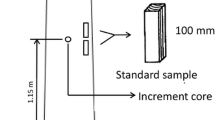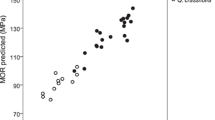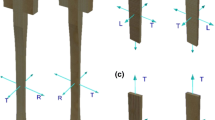Abstract
Poisson's ratios and Young's moduli were measured for five sugar pine (Pinus lambertiana Douglas) boards in a plane delineated by the grain direction and a tangent to the growth increments. One test specimen per board was loaded in a direction parallel to the grain; a second one was loaded perpendicular to the grain in the tangential direction. Test results from four of the five boards fulfilled theoretical expectations with a maximum deviation of ±8 percent for the quotients of Poisson's ratios divided by Young's moduli.
Linear relationships were found to exist between the rate of stress parallel to the load, the rate of strain parallel to the load, and the rate of strain perpendicular to the load. With increasing magnitudes of strain rate, values for Poisson's ratios and Young's moduli approached limit values. It was speculated that at least some of the elastic constants are time dependent. However, the term in the equations which describes that property had large errors.
Similar content being viewed by others
Abbreviations
- A :
-
cross-sectional area of specimen perpendicular to direction of load applicaion
- L :
-
axis parallel to wood grain (parallel to main axis of tree stem)
- R :
-
axis perpendicular to wood grain and radial to circular growth rings
- T :
-
axis perpendicular to wood grain and tangent to circular growth rings
- E R :
-
modulus of elasticity inR direction
- E T :
-
modulus of elasticity inT direction
- E L :
-
modulus of elasticity inL direction
- E 1 :
-
modulus of elasticity in direction of loading
- U 12 :
-
Poisson's ratio: ratio of strain along the direction 2 to the strain along the direction 1 due to stress parallel to the direction 1 (U LT , U LR , U TL , U RL , U RT , U TR )
- \(\varepsilon _1\) :
-
strain in the direction parallel to the load
- \(\varepsilon _2\) :
-
strain in the direction perpendicular to the load
- \(\sigma _1\) :
-
stress in the direction parallel to the load
- dP/dt :
-
rate of load application; measured at upper load limit
- \(d_{\varepsilon 1} /dt\) :
-
rate of strain developed parallel to load; measured at upper load limit
- \(d_{\varepsilon 2} /dt\) :
-
rate of strain developed perpendicular to load; measured at upper load limit
References
Kollman, F. P., andCote, W. A., “Principles of Wood Science and Technology”,Springer-Verlag, New York, Inc., N. Y. (1968).
Doyle, D. V., Drow, J. T. and MacBurney, R. S., “The Elastic Properties of Wood”, U.S. Department of Agriculture, Forest Products Laboratory Mimeo 1528 and Supplements A to H, Madison, Wisc. (1945–1946).
Walker, J. N. andDale, A. C., “Interpretation and Measurement of Strain in Wood”,American Society of Agricultural Engineers, Trans. 6 (1),68–72 (1963).
Sliker, A., “Making Bonded Wire Electrical Resistance Strain Gages for Use on Wood”,Forest Products Journal,17 (4),53–55 (1967).
Kennedy, R. W., “Wood in Transverse Compression: Influence of Some Anatomical Variables and Density on Behavior”,Forest Products Journal,18 (3), 36–40, (1968).
Author information
Authors and Affiliations
Rights and permissions
About this article
Cite this article
Sliker, A. Measuring Poisson's ratios in wood. Experimental Mechanics 12, 239–242 (1972). https://doi.org/10.1007/BF02318105
Issue Date:
DOI: https://doi.org/10.1007/BF02318105




